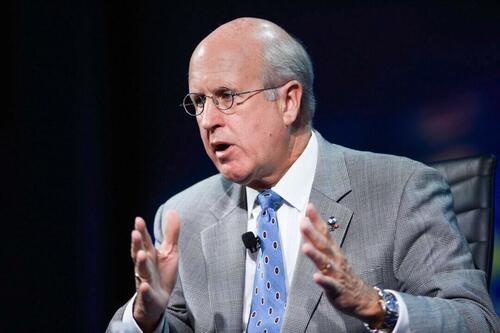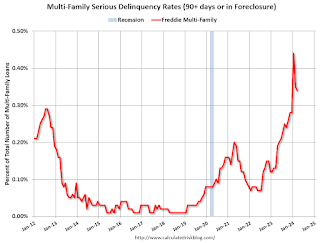Uncategorized
Washington’s Fiscal Mess Is Irresponsible, Unethical, Immoral: Former US Comptroller General
Washington’s Fiscal Mess Is Irresponsible, Unethical, Immoral: Former US Comptroller General
Authored by Andrew Moran via The Epoch Times,
In…

Authored by Andrew Moran via The Epoch Times,
In 2007, the U.S. national debt was below $10 trillion, and the budget deficit was about $160 billion. Federal spending was about $3 trillion, and interest payments were approximately $400 billion.
Then the numbers spiraled out of control.
Washington’s fiscal situation has drastically changed since then; total debt has surpassed $34 trillion, the annual budget shortfall exceeds $1 trillion, and interest costs have topped $1 trillion.
David Walker, the former comptroller general of the United States and a Main Street Economics advisory board member, is unsurprised.
Seventeen years ago, Mr. Walker rang fiscal alarm bells. Like Ross Perot before him, he took his case to the American people and delivered the cold, hard truth: The government’s books are unsustainable, and interest charges on the mounting debt will swallow a significant portion of federal revenues.
During this time, the former head of the Government Accountability Office (GAO) appeared on a widely viewed episode of “60 Minutes,” toured the country to spotlight worrisome trends in the U.S. government’s budget (he did this again in 2012), and attempted to convince lawmakers of the unsustainable fiscal path.
He also penned a 2009 book titled “Comeback America: Turning the Country Around and Restoring Fiscal Responsibility.”
Given the treasure trove of budgetary numbers coming out of the nation’s capital almost daily, such as nearly half of income tax revenues being dedicated to interest payments, Mr. Walker’s warnings have not been heeded nearly two decades later.
According to the Congressional Budget Office’s long-term outlooks, the national debt will eye $50 trillion by 2034, fueled by around $17 trillion in cumulative deficits. As a percentage of GDP, debt held by the public and the deficit will reach 166 percent and 8.5 percent by 2054, respectively, the CBO forecasts.
“Washington has become addicted to spending, deficits, and debt, and they’re charging the credit card and planning to send the bill to younger and future generations of Americans,” Mr. Walker told The Epoch Times.
“That’s irresponsible. It’s unethical, and it’s immoral, and it needs to stop.”
Is the United States past the point of no return?
“Only God knows when the tipping point is going to occur, and God’s not telling us,” he said.
He combs through various metrics to gauge the situation.
One of these is the debt-to-GDP ratio, which is presently at about 122 percent. Outside of the coronavirus pandemic, this is a record high.
Mandatory spending as a percentage of the federal budget is another metric. It currently stands at around 73 percent.
Another one is interest as a percentage of the budget, which is close to 15 percent.
For Mr. Walker, it is not only raw numbers but what the trends are displaying, which requires a deep dive into demographics.
“We have an aging society with longer lifespans, relatively fewer workers, supporting more retirees, and a skills gap,” he noted.
Last year, two notable developments happened: a majority of Baby Boomers were at least 65, and the birth rate tumbled to the lowest in a century.
This will metastasize into a costly burden for the federal government, particularly Social Security.
The Peter G. Peterson Foundation estimates that the current worker-to-beneficiary ratio is 2.8-to-1, down from 5.1-to-1 in 1960. By 2035, the Social Security Administration projects the ratio will further slide to 2.3-to-1.
Republicans and Democrats
President Joe Biden has claimed that he has acted fiscally responsibly, telling a crowd at a North America’s Building Trades Unions event on April 24 that he cut the national debt. President Biden has repeatedly touted this claim over the last 18 months, although he has added close to $7 trillion to the national debt since taking office in 2021.
While Republicans have griped over the current administration’s spending endeavors, experts assert that the GOP has also contributed trillions of dollars to the debt pile. One of the GOP-led expansionist initiatives was Medicare Part D under former President George W. Bush.
This program, which was designed to utilize private health care plans to offer drug coverage to Medicare beneficiaries, added $8 trillion in new unfunded obligations. Mr. Walker accepted that “the politicians were totally out of touch with fiscal reality,” considering that Medicare was already underfunded by $19 trillion.
Former U.S. President George W. Bush speaks at Seminole Golf Club in Juno Beach, Fla., on May 7, 2021. (Cliff Hawkins/Getty Images)
Put simply, both parties have been fiscally irresponsible, and now the bills are coming due.
Mr. Walker purported that politicians suffer from myopia as they are too focused on the next election and, as a result, fearful of making tough decisions. They also experience tunnel vision, he says, meaning they only concentrate on one issue at a time “without understanding the interdependency” and “the collateral effect.”
Self-interest is another malady infecting both sides of the aisle as they aim to keep their jobs and ensure their party stays in power.
“We’ve lost our sense of stewardship,” he said.
“Stewardship is not just generating results today, not just leaving things better off when you leave them when you came, but better positioned for the future,” Mr. Walker explained. “We’ve lost that sense. We need to regain it if we want our future to be better than our past.”
He identified Rep. Jody Arrington (R-Texas), who chairs the House Budget Committee, as one of the few lawmakers to realize the fiscal issues by committing to the Fiscal Commission Act and supporting a constitutional amendment that would limit government growth and stabilize the debt-to-GDP ratio.
“There are others, but there’s not enough,” Mr. Walker said.
Earlier this year, the House Budget Committee advanced the Fiscal Commission Act of 2024 out of committee with bipartisan support.
The bill would establish a 16-member panel featuring six Republicans, six Democrats, and four outside experts without voting power. The group would explore strategies to balance the budget as soon as possible and assess mechanisms to enhance the long-term solvency of various entitlement programs, especially Social Security and Medicare.
Despite some consternation from several Democrats, the bipartisan push received applause, including from the Committee for a Responsible Federal Budget.
“The federal debt is on an unsustainable course, and lawmakers have been unable or unwilling to correct it,” the organization stated. “A fiscal commission would bring Members of both parties and chambers together to facilitate a conversation over how to solve these problems, without pre-prescribing any particular solution (or a solution at all).”
Hope and Change
Whether the United States can improve its fiscal trajectories remains to be seen.
Mr. Walker is hopeful about some of the legislative efforts coming out of the nation’s capital. The country is beginning to face the consequences of years of fiscal mismanagement, making it harder to sell its debt to the rest of the world.
In recent months, many Treasury auctions have led to lackluster demand among domestic and foreign investors. Market watchers have warned that global financial markets might share Fitch and Moody’s concerns about America’s fiscal deterioration.
But when discussing trillions of dollars, percentages, GDP, and servicing costs, how can the average person, worried about paying his mortgage or replacing a broken-down refrigerator, grasp or even be concerned with these trends?
According to Mr. Walker, you tap into their “head and heart.”
“You have to help them understand that we’re already seeing some of the implications of fiscal irresponsibility,” he said, adding that the causes of the Roman Empire’s demise are familiar to what is transpiring in the United States today: fiscal irresponsibility, a decline in moral values, an overextended military, and an inability to control its borders.
However, while it is vital to translate these gigantic numbers into terms the layman can understand, experts also need to “hit their heart.”
“Do they love their country? Do they love their kids, and do they love their grandkids?” he said. “We’re mortgaging their future at record rates.”
Uncategorized
Book Bits: 27 April 2024
● The Algebra of Wealth: A Simple Formula for Financial Security Scott Galloway Q&A with author via New York magazine Q: Over the last ten years…

● The Algebra of Wealth: A Simple Formula for Financial Security
Scott Galloway
Q&A with author via New York magazine
Q: Over the last ten years or so, you had the idea of crypto democratizing finance. Now you have AI democratizing talent, like there’s this hack around wealth and around work.
A: I don’t want to call them get-rich-quick schemes — but the number of people who have made money by buying crypto or buying Nvidia when it was a $10 (now it’s at $800) is small. Even among those few who have managed to do so, a lot give most of it back because they fall under the illusion of thinking it was about skill rather than luck. They double down and start making bigger bets on even riskier assets. The market reminds them in a fairly ugly way that they actually aren’t good. They just got very lucky. I find over the long term, luck is pretty symmetrical. There are people who have made a lot of money in meme stocks; most of them gave it all back because they started conflating luck with talent.
 ● A Wealth of Well-Being: A Holistic Approach to Behavioral Finance
● A Wealth of Well-Being: A Holistic Approach to Behavioral Finance
Meir Statman
Interview with author via Morningstar
Today on the podcast, we welcome back Meir Statman, the behavioral finance expert and author on the connection between financial well-being and life well-being, the role of social comparisons, and more. Meir is the Glenn Klimek Professor of Finance at Santa Clara University. Meir’s latest book is A Wealth of Well-Being: A Holistic Approach to Behavioral Finance. Other books include Behavioral Finance: The Second Generation, What Investors Really Want, and Finance for Normal People. Meir’s research has also been published in the Journal of Finance, the Financial Analyst Journal, the Journal of Portfolio Management, and many other journals. He received his PhD from Columbia University and his BA and MBA from the Hebrew University of Jerusalem.
Uncategorized
Popular fried chicken chain files Chapter 11 bankruptcy
A stack of legal problems has pushed a popular fast-food restaurant chain to file Chapter 11 bankruptcy.

The restaurant industry continues navigating through the aftermath of the Covid-19 pandemic, as many fast-food and fast-casual chains battle financial distress related to reduced foot traffic, as well as inflated food prices and rising interest rates.
Fast-casual Tex-Mex chain Tijuana Flats Restaurants on April 19 filed for Chapter 11 bankruptcy in the U.S. Bankruptcy Court for the Middle District of Florida, after launching a strategic review in November 2023 seeking answers for turning around the struggling chain.
Related: Bankrupt fast-food chain exits Chapter 11; to expand size 4 times
The company sold the company to a new ownership group, closed 11 of its locations and filed for a bankruptcy reorganization to revitalize its restaurants and reinvigorate the customer experience.
Reorganization, however, is not an option for another restaurant chain, as Foxtrot and Dom’s Kitchen & Market, with 33 locations across the U.S., filed for Chapter 7 liquidation on April 23 after failing to recover from financial distress dating back to the Covid pandemic.
Another restaurant chain, Sticky's, will have a chance to recover from the Covid pandemic's effects through a reorganization plan.
Sticky's to reorganize in Chapter 11
Sticky's Holdings, the parent company of New York-based chicken fingers fast-food chain Sticky's, filed for Chapter 11 bankruptcy on April 25 to reorganize its business after suffering financial distress from reduced traffic following the Covid pandemic, rising commodity prices, and lawsuits.
The debtor listed $5.75 million in assets and $4.67 million in liabilities in its petition. It's largest unsecured creditor is US Foods, owed over $449,000.
Sticky's, which opened in 2012, grew in sales from about $500,000 in 2013 to $22 million in 2023, but the Covid pandemic that significantly affected the restaurant industry starting in 2020 depressed store traffic. Revenue suffered and foot traffic has not returned to pre-pandemic levels, according to a declaration filed by Sticky's CEO Jamie Greer.
Rising inflation caused commodity prices to increase, forcing Sticky's to raise its menu prices, which further stifled traffic to the restaurant chain. As part of its efforts to reduce costs, the company in early 2021 exited its corporate offices on East 33rd Street in New York before its lease expired, according to the declaration.
Related: Luxury appliance retailer files Chapter 7 bankruptcy to liquidate
Legal problems drive restaurant chain to bankruptcy
The debtor's landlord filed a summary judgment on June 22, 2021, to recover the remaining rent and legal fees, which a court granted with a $600,000 award. The debtor has appealed the judgment costing the company more in legal fees.
More legal problems fell on Sticky's as on June 30, 2022, Sticky Fingers Restaurants LLC filed a lawsuit against Sticky's Holdings in the U.S. District Court for the Southern District of New York for alleged trademark infringement violations. The costs and expenses related to the ongoing litigation has imposed significant further financial hardship on the debtor, court papers said.
The debtor on Feb. 23, 2024, entered into an equity financing transaction that converted $2.42 million in convertible notes issued Nov. 9, 2022, and due March 31, 2024. The transaction substantially reduced the debtor's short-term liquidity needs, the declaration said. However, the company's financial headwinds prevented the debtor from continuing operations leading it to file bankruptcy to seek a reorganization.
Sticky's is a chain of chicken fingers and sandwich restaurants that serves fresh, never frozen and antibiotic-free chicken. It offers 18 in-house sauces for its chicken products.
Sticky's currently operates 12 locations, with nine in New York and three in New Jersey. It has closed two locations in New York and one each in New Jersey and Pennsylvania. The company had established a franchise entity to operate potential franchise operations, but none opened.
Related: Veteran fund manager picks favorite stocks for 2024
bankruptcy pandemic covid-19 stocks interest ratesUncategorized
Fannie and Freddie: Single Family Serious Delinquency Rate Decreased, Multi-family Decreased in March
Today, in the Calculated Risk Real Estate Newsletter: Fannie and Freddie: Single Family Serious Delinquency Rate Decreased, Multi-family Decreased in March
Brief excerpt: Single-family serious delinquencies decreased in March, and multi-family serious …

Brief excerpt:
Single-family serious delinquencies decreased in March, and multi-family serious delinquencies decreased again after the huge surge in January.
...
Freddie Mac reports that the multi-family delinquencies rate declined to 0.34% in March, down from 0.35% in February, and down from 0.44% in January.
This graph shows the Freddie multi-family serious delinquency rate since 2012. Rates were still high in 2012 following the housing bust and financial crisis.
The multi-family rate increased following the pandemic and has increased recently as rent growth has slowed, vacancy rates have increased, and borrowing rates have increased sharply. The rate surged higher in January but declined in February and March - but is still at a high level. This will be something to watch as more apartments come on the market.
-

 Government3 weeks ago
Government3 weeks agoClimate-Con & The Media-Censorship Complex – Part 1
-

 International1 week ago
International1 week agoJ&J’s AI head jumps to Recursion; Doug Williams resigns as Sana’s R&D chief
-

 Government4 days ago
Government4 days agoCOVID-19 Vaccine Emails: Here’s What The CDC Hid Behind Redactions
-

 International2 weeks ago
International2 weeks agoWHO Official Admits Vaccine Passports May Have Been A Scam
-

 Spread & Containment3 weeks ago
Spread & Containment3 weeks agoFDA Finally Takes Down Ivermectin Posts After Settlement
-

 Uncategorized4 weeks ago
Uncategorized4 weeks agoVaccinated People Show Long COVID-Like Symptoms With Detectable Spike Proteins: Preprint Study
-

 Uncategorized21 hours ago
Uncategorized21 hours agoPopular fast-food restaurant chain files Chapter 11 bankruptcy
-

 Uncategorized3 weeks ago
Uncategorized3 weeks agoCan language models read the genome? This one decoded mRNA to make better vaccines.














